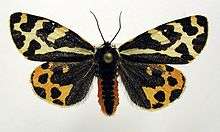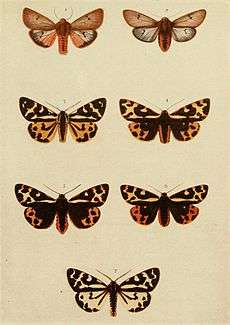Parasemia plantaginis
| Wood tiger | |
|---|---|
 | |
| Male | |
 | |
| Mounted | |
| Scientific classification | |
| Kingdom: | Animalia |
| Phylum: | Arthropoda |
| Class: | Insecta |
| Order: | Lepidoptera |
| Superfamily: | Noctuoidea |
| Family: | Erebidae |
| Subtribe: | Arctiina |
| Genus: | Parasemia |
| Species: | P. plantaginis |
| Binomial name | |
| Parasemia plantaginis (Linnaeus, 1758) | |
| Synonyms | |
| |
Parasemia plantaginis, the wood tiger, is a moth of the family Erebidae. Several subspecies are found in the Holarctic ecozone south to Anatolia, Transcaucasus, northern Iran, Kazakhstan, Mongolia, China, Korea and Japan. One subspecies is endemic to North America.

Description
The wingspan is 32–38 mm. This moth is extraordinarily variable. Normally it has a black forewing in both sexes, with moderately broad, ivory yellow bands. The hindwing is yellow in the male, with an irregular marginal band which is often interrupted, and 2 or 3 submarginal spots. The basal portion of the hindwing bears black streaks at the margin of the cell, and before the anal margin. In the female the hindwing is red above with the base strongly black. Numerous aberrations have been found and named, which often occur predominantly, often only exceptionally among typical specimens. Major aberrations are listed by Seitz, 1913 [1]
Biology
The moth flies from June to July depending on the location.
The larvae feed on plantains, hawkbits, hawkweeds, and other low-growing plants.
Subspecies
- Parasemia plantaginis plantaginis
- Parasemia plantaginis araitensis Matsumura, 1929
- Parasemia plantaginis carbonelli de Freina, 1993
- Parasemia plantaginis caspica Daniel, 1939
- Parasemia plantaginis caucasica (Ménétriès, 1832)
- Parasemia plantaginis hesselbarthi de Freina, 1981
- Parasemia plantaginis interrupta Draudt, 1931
- Parasemia plantaginis kunashirica Bryk, 1942
- Parasemia plantaginis macromera (Butler, 1881)
- Parasemia plantaginis melanissima Inoue, 1976
- Parasemia plantaginis melanomera (Butler, 1881)
- Parasemia plantaginis nycticans (Ménétriès, 1859)
- Parasemia plantaginis petrosa (Walker, 1855)
- Parasemia plantaginis sachalinensis Matsumura, 1930
- Parasemia plantaginis sifanica (Grum-Grshimailo, 1891)
Gallery
 Caterpillar
Caterpillar Adult
Adult- Habitat in Ireland
References
- ↑ Adalbert Seitz in Seitz, A. Ed. Die Großschmetterlinge der Erde, Verlag Alfred Kernen, Stuttgart Band 2: Abt. 1, Die Großschmetterlinge des palaearktischen Faunengebietes, Die palaearktischen Spinner und Schwärmer, 1912- 1913 Volume 2 (page 81) online In English translation
External links
| Wikimedia Commons has media related to Parasemia plantaginis. |
- Lepiforum
- Fauna Europaea
- Wood tiger on UKmoths
- Research group working on Parasemia plantaginis diversity and warning signals at the University of Jyväskylä in Finland